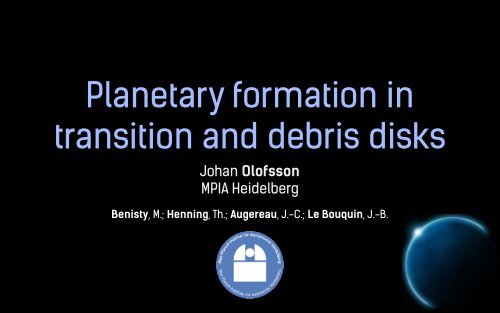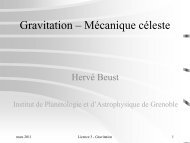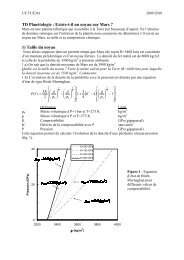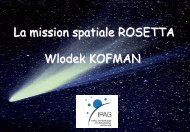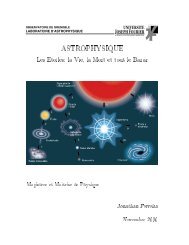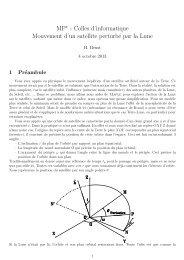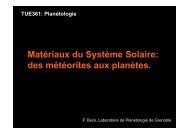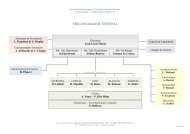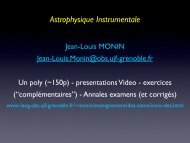Johan Olofsson MPIA Heidelberg
Johan Olofsson MPIA Heidelberg
Johan Olofsson MPIA Heidelberg
You also want an ePaper? Increase the reach of your titles
YUMPU automatically turns print PDFs into web optimized ePapers that Google loves.
Planetary formation in<br />
transition and debris disks<br />
<strong>Johan</strong> <strong>Olofsson</strong><br />
<strong>MPIA</strong> <strong>Heidelberg</strong><br />
Benisty, M.; Henning, Th.; Augereau, J.-C.; Le Bouquin, J.-B.
Motivation
Giant & telluric planetary formation<br />
‣ Giant planetary formation (<strong>Olofsson</strong> et al. 2013a)<br />
‣ The transition disk around TCha: how to sculpt a disk <br />
‣ I’m confused, is there a planet in the end <br />
‣ Terrestrial planetary formation (<strong>Olofsson</strong> et al. 2013b)<br />
‣ The warm debris disk around HD 113766 A<br />
‣ The origin of the transient dust: a massive collision
The transition disk around TCha<br />
‣ Main characteristics of TCha:<br />
‣ Solar-type star (G8), 7 Myr old<br />
‣ Far-IR excess (cold dust)<br />
‣ Near-IR excess (warm dust)<br />
‣ Lack of mid-IR (no dust)
The transition disk around TCha<br />
‣ Fact: the disk is dissipating. Question: how <br />
‣ (hint: there is a strong near-IR excess)<br />
‣ Circumbinary disk Single star (optical spectroscopy)<br />
‣ Grain growth Would affect the innermost regions first<br />
‣ Photo-evaporation Same as above<br />
‣ Gap opened by a planet <br />
‣ We need spatially resolved observations !
The power of interferometry<br />
‣ Near- & mid-IR interferometry at the VLTI<br />
‣ High angular resolution: few milli-arcsec (1 mas, 0.1 AU @ 100 pc)<br />
‣ Near-IR: sensitive to warm dust<br />
‣ Let’s use all possible VLTI facilities !<br />
‣ AMBER (<strong>Olofsson</strong> et al. 2011)<br />
‣ PIONIER, MIDI, NaCo/SAM (<strong>Olofsson</strong> et al. 2013a)<br />
‣ MCFOST = SED + raytraced images (V 2 , closure phases)<br />
‣ Multi-techniques, multi-wavelength, multi-resolution
The inner disk<br />
‣ Narrow disk: 0.07-0.11 AU<br />
‣ High temperatures: sublimation of smallest silicates (1500 K)<br />
‣ Large scale height: H/R = 0.2<br />
‣ High temperature gas <br />
‣ (Thi et al. 2011)<br />
‣ Warped disk (optical variability<br />
‣ Schisano et al. 2009)<br />
‣ ISAAC proposal: time monitoring
The outer disk<br />
‣ Most likely narrow: 12-25 AU (Cieza, <strong>Olofsson</strong> et al. 2011)
The outer disk<br />
‣ Most likely narrow: 12-25 AU (Cieza, <strong>Olofsson</strong> et al. 2011)<br />
SED Pionier - V 2 NaCo SAM - V 2<br />
MIDI<br />
Pionier - CP
The importance of the field-of-view<br />
‣ The outer disk is in the Pionier, MIDI and SAM field-of-view<br />
‣ Over-resolved, extended emission: drop in V 2 at short baselines<br />
‣ Constraints on the outer disk, even with Pionier
A candidate companion<br />
‣ Huélamo et al. (2011): NaCo/SAM closure phases w/ binary model<br />
‣ L’-band detection, distance of 6.7 AU (in the gap), mass < 80 M Jup<br />
‣ Closure phases: departure from centro-symmetry<br />
‣ Anisotropic (forward) scattering: asymmetric surface brightness
A candidate companion<br />
‣ Equivalent goodness of fit for the disk and binary models<br />
‣ Assumptions made are not equivalent<br />
Companion model<br />
T Cha<br />
MCFOST model<br />
5<br />
5<br />
5<br />
v (meters)<br />
0<br />
v (meters)<br />
0<br />
v (meters)<br />
0<br />
−5<br />
−5<br />
−5<br />
−1 deg −0.5 deg 0.5 deg 1 deg<br />
−1 deg −0.5 deg 0.5 deg 1 deg<br />
−1 deg −0.5 deg 0.5 deg 1 deg<br />
5<br />
0<br />
−5<br />
5<br />
0<br />
−5<br />
5<br />
0<br />
−5<br />
u (meters)<br />
u (meters)<br />
u (meters)<br />
‣ Companion has to be unambiguously detected
Hints for a companion<br />
‣ Large gap in the disk: several AU<br />
‣ A narrow outer disk (12-25 AU), why <br />
‣ Herschel PACS & SPIRE observations (Cieza, <strong>Olofsson</strong> et al. 2011)<br />
‣ Pressure maximum caused by a 1-15 M Jup planet<br />
‣ Pile-up of mm-sized grains: good far-IR emitters<br />
‣<br />
Pinilla, Benisty & Birnstiel (2012)
Giant planetary formation in TCha<br />
‣ Narrow inner disk at the sublimation temperature<br />
‣ Large gap: room for one or more planet of a few M Jup<br />
‣ Still to be detected<br />
‣ Narrow outer disk: consequence of planet-disk interactions <br />
‣ May appear truncated in the population of mm-sized grains<br />
‣ Could be more extended for other grains sizes<br />
‣ Need for direct imaging: ALMA, NaCo/ADI !
Debris disk<br />
Final product of star formation<br />
Kuiper-belt like<br />
Reservoir of planetesimals<br />
Cold dust (50 K)<br />
100s of known objects<br />
Optically thin<br />
Typical ages > 10-20 Myr
Warm debris disk<br />
Final product of star formation<br />
Inner belt<br />
Kuiper-belt like<br />
Reservoir of planetesimals<br />
Cold dust (50 K)<br />
100s of known objects<br />
Warm dust (500 K)<br />
Rare objects<br />
Optically thin<br />
<br />
Typical ages > 10-20 Myr
Warm debris disk around HD 113766 A<br />
‣ High IR luminosity associated with the disk<br />
‣ Not a steady-state evolution of the disk: transient dust<br />
‣ Detection of emission features in IRS spectrum<br />
‣ Warm, small silicate dust grains<br />
‣ Origin of the dust:<br />
‣ Massive collision<br />
‣ Outer dust belt “feeding” the inner regions<br />
‣ (e.g., comets, Beichman et al. 2005, Bonsor et al. in prep)
Methodology<br />
‣ Herschel/PACS observations: cold dust<br />
‣ VLTI/MIDI observations: warm dust<br />
‣ DEBRA code (<strong>Olofsson</strong> et al. 2012):<br />
‣ SED modeling, spectral decomposition & raytraced images
One or two dust belts<br />
‣ One dust belt: extended disk (0.4-50 AU)<br />
‣ Severely under-predict the MIDI observations
One or two dust belts<br />
‣ Two dust belts: 0.6-1 AU & 9-13 AU<br />
‣ Good match to all the observations<br />
‣ Limitations of SED modeling !
Origin of the dust<br />
‣ Massive collision<br />
‣ Outer dust belt “feeding” the inner regions (e.g., comets)
Origin of the dust<br />
‣ Comet “outgasing” radius<br />
‣ r ~ 3.3 AU for a 4.4 L ⦿ star (Bonsor et al. in prep)<br />
‣ MIDI data: r < 1 AU<br />
‣ Dust composition: crystalline olivine grains<br />
‣ Enrichment in Fe compared to Mg (unusual petrology)<br />
‣ Possible explanation: differentiated planetesimals<br />
‣ (e.g., Nakamura et al. 2011; de Vries et al. 2012)<br />
‣ Catastrophic collision between such planetesimals
Origin of the dust<br />
‣ HD 113766 A: 10-16 Myr old<br />
‣ Timeframe for telluric planetary formation (Kenyon & Bromley 2006)<br />
‣ Stirring by large planetesimals: highly unstable period of time<br />
0.7-1.3 AU<br />
0.4-2 AU
Giant & telluric planetary formation<br />
‣ The case of TCha<br />
‣ One (or more) planet(s) to be unambiguously detected in the gap<br />
‣ Perfect laboratory to test planet formation theories<br />
‣ Need for high resolution direct imaging<br />
‣ The case of HD 113766 A<br />
‣ Aftermath of a collision between differentiated planetesimals<br />
‣ Need to spatially resolve the outer belt
Take away messages<br />
‣ SED modeling is awesome, until you obtain spatially resolved data<br />
‣ ➔ Study the dust<br />
‣ ➔ Study the disk<br />
‣ ➔ Planet-disk interactions<br />
‣ ➔ Study planets<br />
‣ Dust mineralogy never fails to provide valuable constraints<br />
‣ (e.g., <strong>Olofsson</strong> et al. 2009; 2010, 2012, 2013b)<br />
(shameless advertising, on the last slide)


